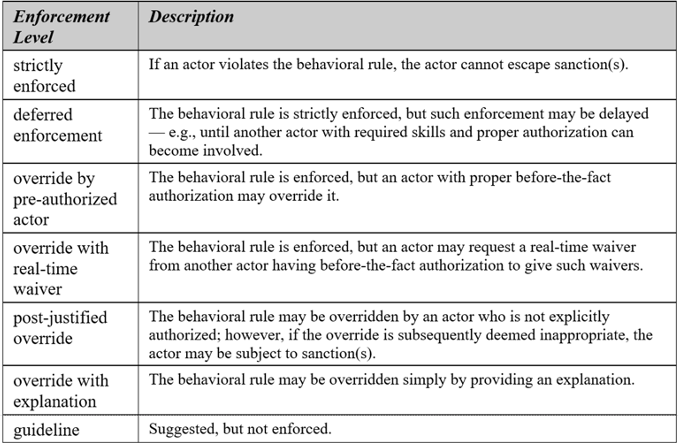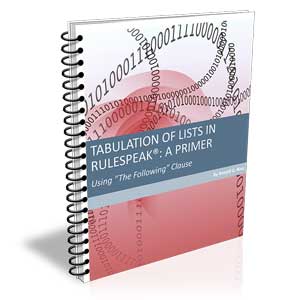What Else Should Rule Platforms Be Doing?
Addressing Sentiment and Human Discretion Better
In running a business, it is impossible to foresee every circumstance that might occur and prepare purely rule-based scenarios for them all in advance that can execute automatically. Does that mean you shouldn't use a rules-based approach? Of course not!
What it means is that in many situations your rules approach needs to be as friendly as possible to real-time insertion of sentiment, human discretion, and common sense.
Decision models and decision tables tend to be brittle in that regard. Maybe we have been asking too much of decision logic and DMN?!
Sample Scenario
These days your organization is likely to have strict rules about inappropriate touching. Here's a sample.
No-Hugs Rule: An employee is not permitted to wrap arms around another employee and squeeze.
Engaging in this behavior while at work can result in the termination of the employee. But are there circumstances where it can be broken? Imagine the following scenario.
One day you go to the kitchen area for some coffee and notice one of your coworkers has his hands grasped around his throat and is turning blue. The coworker is choking and unable to breathe. So, you get behind them and extend your arms and wrap them around their body and squeeze. That's an action commonly known as the Heimlich Maneuver.
Unfortunately, a manager happens to walk by and sees the incident in progress. They tell you to cease immediately, then walk you straight to the HR office where you are told your employment is terminated. You violated the rule and the penalty is to be let go.
That would be pretty dumb. By 'hugging' the co-worker, you may have saved their life. I imagine the coworker, thinking they were about to die, would be eternally grateful. Common sense dictates the No-Hugs Rule should be broken if circumstances warrant. What's needed here? Some real-time human discretion.
Specifically, in circumstances that might not have been foreseen when the rule was written, there needs to be allowance for it to be broken without sanction. In the real world of people, rules can and sometimes should be violated. As my mother used to say, "Know the rules well enough to know when to break them."
That's why it's important to recognize there are two kinds of rules, not one.
- Definitional Rules
This kind of rule cannot be broken. A definitional rule might be bad or wrong, but it can't be violated. Of course, you can choose to ignore the results, but that's an entirely different matter.
Example: A customer must be considered a gold customer if the customer places more than 12 orders during a calendar year.
Decision rules and decision tables fall into this first category.
- Behavioral Rules
Behavioral rules can be violated or broken. They govern the conduct of on-going activity and so are critical to people, organizations, and business activity. Very roughly, you can think of behavioral rules as business constraints.[1]
Example: A customer must be assigned to an agent if the customer has placed an order.
The idea that any kind of rule can be broken is very foreign to DMN and to the traditional expert systems community (symbolic AI). Indeed, I've looked at enough decision models and decision tables to know that behavioral rules simply go missing in them. In our approach we don't allow that to happen.
A crucial question for each behavioral business rule is how strictly does it need to be enforced? That's a highly-empowering question both for business agility, as well as for business analysis.
In the case of the No-Hugs Rule, you probably want to specify that it can be over-ridden in case of verifiable emergency. That's how you inject human discretion, common sense, and sentiment into business logic in real time.
Automating Behavioral Rules
Although the No-Hugs Rule is not realistically automatable (probably), a significant majority of behavioral business rules are directly automatable. That's certainly true for the EU-Rent and examples I discussed previously.[2]
In recent years, however, I've learned to be careful what I say about automation. Here's why. This is an example of a behavioral rule I've used in training for over 20 years.
Rule: A hard hat must be worn in a construction site.
A few years ago, it dawned on me that these days AI and ML are fully capable of determining when a worker is wearing a hard hat. It's simply a matter of automated detection. So, now I see a huge opportunity to use AI and ML in combination with behavioral business rules. By doing so we can achieve pragmatic kinds of automation never before imagined possible.
Enforcement Level
A unique feature of behavioral business rules is enforcement level. In soccer, for example, a yellow card is a very different enforcement level than a red card (or just a warning). How strictly you want a behavioral rule to be enforced and what you want to do in response to violations are different questions from the logic the rule itself expresses. Table 1 presents a set of common-sense enforcement levels.[3]
Table 1. Common-Sense Enforcement Levels for Behavioral Business Rules

As indicated in Table 1, enforcement level for behavioral rules can range all the way from strictly enforced at the high end to not enforced at all at the low end.
Knowledge on the Fly
Wait a minute, what's the point of a rule that's not enforced at all? Such a rule is simply a guideline or suggestion.
Indicating a rule as a guideline doesn't mean it doesn't do anything. Far from it. With automated support, it means you're disseminating knowledge in real-time even if you don't literally enforce the rule. By doing so, the rule platform educates participants in the workspace about the latest policies and best practices, right on the spot. Hopefully, they modify their behavior accordingly.
Now that's really, really smart![4]
Shut Down the Business?
I've heard people object that you can't simply shut down the business while some violation to a behavioral rule is fixed.
First of all, that's simply not the case. You'd almost always be delaying just one particular interaction or, in the worst case, just a set of interactions.
If the issue still concerns you, however, you can always choose the second enforcement level in the list, which is to defer the enforcement until the violation can get fixed.[5]
In the Knowledge Age, a rule platform that can't address these real-time issues is missing a huge opportunity.
References
[1] For more about behavioral business rules, refer to the second article in this series:
Ronald G. Ross, "What Else Should Rule Platforms Be Doing? Eliminating Programmer Workload," Business Rules Journal, Vol. 23, No. 02 (Feb. 2022)
URL: http://www.brcommunity.com/a2022/c087.html
[2] Refer to the previous article in this series:
Ronald G. Ross, "What Else Should Rule Platforms Be Doing? Where DMN and Decision Models Fall Short," Business Rules Journal, Vol. 23, No. 03 (Mar. 2022)
URL: http://www.brcommunity.com/a2022/c089.html
[3] Ronald G. Ross with Gladys S.W. Lam, Building Business Solutions: Business Analysis with Business Rules (2nd ed), Business Rule Solutions (2015), pp. 186-189.
[4] For such support you need what I call a watcher and support for flash points. Refer to the second article in this series:
Ronald G. Ross, "What Else Should Rule Platforms Be Doing? Eliminating Programmer Workload," Business Rules Journal, Vol. 23, No. 02 (Feb. 2022)
URL: http://www.brcommunity.com/a2022/c087.html
[5] You need to do that for many timing rules anyway since you literally can't stop the clock.
# # #
About our Contributor:
Online Interactive Training Series
In response to a great many requests, Business Rule Solutions now offers at-a-distance learning options. No travel, no backlogs, no hassles. Same great instructors, but with schedules, content and pricing designed to meet the special needs of busy professionals.











How to Define Business Terms in Plain English: A Primer
How to Use DecisionSpeak™ and Question Charts (Q-Charts™)
Decision Tables - A Primer: How to Use TableSpeak™
Tabulation of Lists in RuleSpeak®: A Primer - Using "The Following" Clause
Business Agility Manifesto
Business Rules Manifesto
Business Motivation Model
Decision Vocabulary
[Download]
[Download]
Semantics of Business Vocabulary and Business Rules